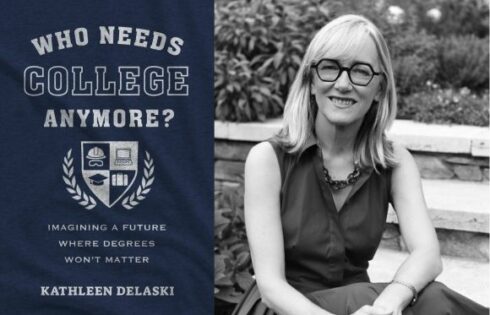
OPINION: Harvard should prioritize truth, open inquiry instead of DEI
As universities look ahead to the new school year, we are reminded that the selection of a college president holds paramount importance for the future direction of institutions.
Earlier this year, Claudine Gay, Harvard University’s first black president, resigned in the wake of controversies around her Congressional testimony and apparent plagiarism, making her tenure as president the shortest in Harvard’s nearly 400-year history.
Some have claimed that Harvard’s next president must, like Gay, be black. However, it’s worth remembering that Gay, while a first at Harvard, was not the first black president in the Ivy League. Nor was Gay the first black woman to lead an Ivy League school.
Both of those distinctions go to Ruth Simmons, president of Brown University from 2000 through 2012. I returned to Brown’s faculty from a fellowship at Harvard near the start of Simmons’ presidency and had a front-row seat throughout Simmons’ term.
Leading an Ivy League university a decade before the rise of the DEI movement, Simmons was a Civil Rights-era pioneer. As Harvard begins the search for its next president, Simmons’ example offers a lesson about the relative importance of race and vision when selecting a university leader. But Simmons’ presidency also offers a deeper reminder about the promise and beauty of scholarship itself. In this, Simmons’ example helps us calibrate the stakes in the choice that Harvard must make.
Simmons took over the Brown presidency at a moment of elevated racial tension. In her first convocation address, Simmons talked about the values of open inquiry and viewpoint diversity. Tapping the religious roots of the Civil Rights movement, Simmons described scholarship as “glory work” and declared that those who pursue knowledge with seriousness and integrity – even if they express views that may distress others — remain “righteous in their cause.”
“While other types of communities devise covenants so as to avoid conflict, our covenant is rooted in quarrel, in opposition,” Simmons said that day. “We encourage ideas and opinions to collide in the service of learning. We freely trespass boundaries, criticize each other’s views, test every theory. No idea is beyond range or out of bounds.”
Simmons’ actions as president backed up her declaration that the purpose of the university is the pursuit of knowledge. For her chief academic officer, Simmons recruited a Jewish mathematician from the University of Chicago named Robert Zimmer.
MORE: Of course Harvard’s president is a diversity hire
Later, as the president of the University of Chicago, Zimmer would form a Committee on Freedom of Expression whose report defending free speech, known as the Chicago Principles, has been adopted in some form by over 100 colleges and universities. Simmons’ 2005 strategic plan, Boldly Brown, eschewed symbolic gestures and focused instead on scholarly goals: building new research centers, boosting support for graduate studies and increasing the total number of Brown faculty positions by a whopping twenty percent.
Simmons’ vision of the university as a community convened for the pursuit of knowledge did not render her insensitive to issues of social justice. But here too Simmons’ approach was unapologetically scholarly. In 2004, she created a Committee on Slavery and Justice to investigate the history of Brown’s connection to the slave trade and to do so from a variety of points of view.
This project was a novelty, in both aspects. Rather than working for the news cycle, Simmons gave the Committee two full years to produce its report. In 2014, Brown erected a sculpture on campus to recognize the university’s connection to the slave trade and the work of Africans and African Americans, enslaved and free, who helped build Brown University and our nation. Fittingly, the plaque also honors the process by which the report was produced.
Simmons’ presidency was not without flaws. On the crucial but stubborn problem of ideological imbalance on the faculty, for example, her presidency achieved little if any improvement (here and here). Still, Simmons’ example shines.
Advocates of today’s “diversity equity and inclusion” movement see the world through a racialized lens. Thus, predictably, they insist that race should be an overriding factor in the selection of college presidents, at Harvard and beyond. But the Civil Rights paradigm, with Ruth Simmons as an exemplar, points us to a deeper metric.
Harvard should choose its next president, whatever his or her race, for their commitment to excellence in the pursuit of knowledge, demonstrated by a record of supporting open inquiry and viewpoint diversity.
The selection of such a leader at Harvard might provide a timely reminder to our country that there is something beautiful and enduring about the work done at universities—whatever their current shortcomings. Indeed, the scholarly efforts of professors and students, when undertaken with seriousness and integrity, still hold out the possibility of someday re-earning that Civil Rights mantle: glory work.
Editor’s note: John Tomasi, D.Phil., is President of Heterodox Academy. He previously was Romeo Elton 1843 Professor of Natural Theology at Brown University.
MORE: Claudine Gay will teach ‘reading and research’ this fall
IMAGE: Harvard University/YouTube
Like The College Fix on Facebook / Follow us on Twitter





Please join the conversation about our stories on Facebook, Twitter, Instagram, Reddit, MeWe, Rumble, Gab, Minds and Gettr.